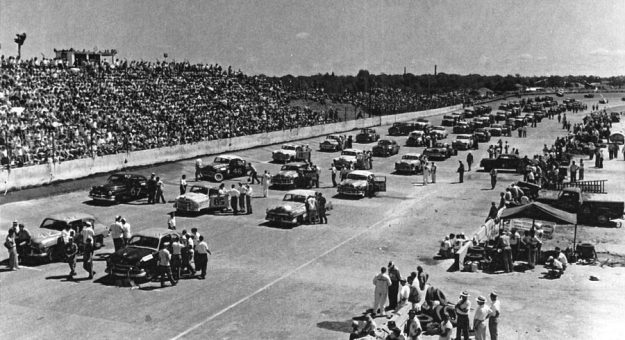As the number of NASCAR-sanctioned races, competitors and spectators exploded in the initial three years of the organization’s history, 1951 became the year in which the leaders of NASCAR codified the foundation for the future of stock car racing in the United States.
Specifications for the automobiles in NASCAR-sanctioned events appeared in the Jan. 3 issue of NSSN. American strictly stock, American modified stock, European strictly stock and sports and custom-built automobiles competed during the annual Daytona Beach Speed Week under the guidelines set forth.
For instance, American strictly stock cars, which raced on the Grand National circuit, fell into five classes according to engine size. Class one included cars with up to 100 cubic-inch piston displacement, class two covered cars with engines from 101 to 200 cubic inches and so on up to class five, which held cars with engines over 301 cubic inches.

While only modifications designed to protect the driver altered strictly-stock cars, each of the other three divisions allowed supercharged engines and optional equipment, such as dual gas tanks, not found on cars off the track.
NASCAR garnered more attention off the track as the year progressed, particularly from lawmakers concerned with the safety of motorsports. Legislators in California, where the Grand National circuit competed for the first time in 1951, introduced a bill which sought to limit the number of participants in any race to 12 for reasons of safety.
The politicians reasoned that limiting the number of cars in a race led to fewer accidents and fewer unpaid medical bills, heretofore the bane of motorsports. In Pennsylvania debates about the construction of new race tracks raged.
Initial Safety Concerns
Meanwhile, Bill France sought to allay the safety concerns of the public by declaring NASCAR would only sanction race promoters who possessed a minimum of $10,000 public liability insurance.
This protected the promoter from legal claims by the public, injured drivers and rival promoters. No sanctioning body before enjoyed such a policy, which also ensured the payment of medical expenses resulting from accidents at the track.
Debates about racing’s safety failed to deter NASCAR’s continued growth throughout the nation. Wall Stadium in New Jersey signed with NASCAR with the pronouncement: “The management of Wall Stadium feels that NASCAR, being the largest and most popular in the East, has the most to offer the Stadium fans,” according to the April 11 issue of NSSN.
That confidence was shared by tracks in Morristown, N.J., Mobile, Ala., Thompson, Coon., and Wilson, N.C., among others, which hosted race meets for the first time.
The Western Front
Farther west, NASCAR drivers made inaugural appearances at California tracks in Oakland and Gardena and in Phoenix, Ariz.

Traveling to the far comers of the country failed to deter Herb Thomas in his run to the Grand National point championship. Thomas earned four poles and seven victories driving his 1950 Plymouth in 35 of the 41 scheduled Grand National events.
Yet, much of the season Thomas trailed Tim and Fonty Flock and Daytona Beach victor Marshall Teague in the championship race. Fonty Flock drove very well throughout the season. Flock pushed his 1950 Oldsmobile 88 to eight victories in 34 starts. He also led more than 1,300 laps in 21 races and set four qualifying records en route to a second-place points finish, 46 markers behind Thomas.
Tim Flock used seven victories to grab third in the points race while Teague, who was in the top three at the time, lost his accrued points and paid a $579.50 fine for participating in the non-NASCAR-sanctioned Mexican Pan-American Road Race.
Bill France warned all 4,500 NASCAR members of the penalty for driving in the second annual event, in which he competed the year before, yet Teague and several others paid the price. In NASCAR’s other divisions, Mike Klapak reigned in the sportsman class once more and Roscoe Hough held the Short Track title.
New Jersey comer Wally Campbell earned the modified championship and, at the conclusion of 1951, Wade Fields led NASCAR’s new Citrus Circuit, which was still in progress as was NASCAR’s nationwide expansion.
Editor’s Note: NASCAR is celebrating its 75th anniversary in 2023. SPEED SPORT was founded in 1934 and was already on its way to becoming America’s Motorsports Authority when NASCAR was formed. As a result, we will bring you a 75-part series on the history of NASCAR as told in the pages of National Speed Sport News and SPEED SPORT Magazine.
